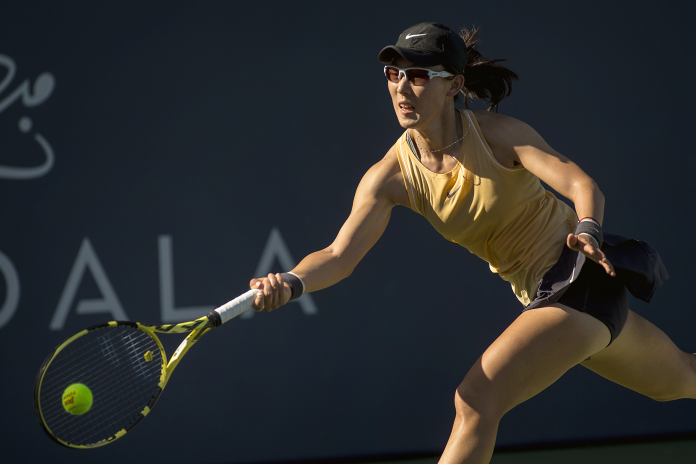Bill Simons
San Jose
Follow us here. The first victory by a Chinese player in the 48-year history of the WTA’s Bay Area tourney can be traced directly to what happened in a hotel a town or two away from San Jose. Amidst all the frenzy of the 1982 Fed Cup in Santa Clara, which featured Chris Evert and Martina Navratilova, a 19-year-old secretly slipped away. But the Chinese teen named Hu Na was no ordinary kid. In a Cold War world, she was China’s hot tennis prospect. The communists loved her. She played mixed doubles with the big honchos.
Naturally, they were livid when she defected to the US. Embarrassed and furious, they roared: “We hereby demand the US takes effective measures to find and immediately send [Hu Na] back to our team.” The Chinese Foreign Ministry said the defection was “sure to adversely affect the cultural exchanges between the two countries.”
Hu Na is now an artist in London. But at that time, in her homeland, she was seen as a traitor. Here she was celebrated, and to this day her bravery has a heroic ring. Her defection was the first chapter in the book of modern Chinese tennis. Michael Chang would advance the narrative, and Li Na’s impact can’t be underestimated.
Now the powerhouse nation, with its 1.42 billion people, is at the heart of tennis’ eastward tilt, as tourney after tourney has headed off to Asia.
Just two weeks ago at the Hall of Fame induction ceremony in Newport, there was lots of appropriate praise for the brave, pioneering ways of Li Na, the two-time Slam champ who put Chinese tennis on the map. This week here in the Bay Area, another Chinese woman stepped up. Her name is brief. Her resume is thin. Her stature is modest – just 5’7″. Zheng Saisai had never won a WTA title. So what?
In San Jose, the tall players with the long resumes made plenty of noise but fell short at the Mubadala Silicon Valley Classic. Two-time Slam winner 6’0″ Garbiñe Muguruza didn’t even make it to the starting line. Venus Williams, the 6’1” icon, did just what her sister Serena did last year. She quietly fell in the first round without too much of a fuss. Neither two-time Slam winner Vika Azarenka nor top-seed Elina Svitlona even made it to the weekend.
To become the first Chinese finalist at the tourney, the vastly appealing Zheng had to beat a Guernsey girl, a fisherman’s daughter, a Jersey girl and a Spartan. That would be Britain’s Heather Watson, who was born on the island of Guernsey, Danielle Collins, whose dad is a fisherman, the seventeen-year-old bound-for-glory Jersey-born Amanda Anisimova, and last year’s finalist Maria Sakkari who proudly proclaimed “I’m a Spartan.”
Never mind that four of Zheng’s foes had far better rankings. Saisai seemed in an almost magical zone. Time and again she scampered to the right place. She seemed to have a sixth sense of where to be. Anisimova is known to have a big power game. Zheng absorbed her power like a sponge. Never mind that Saisai’s 88 mph serves did little damage, or that big weaponry isn’t her thing. It was a similar story against Spartan Sakkari, whose legs were heavy and who was driven loopy by Zheng’s loopy shots.
Simply put, Saisai put on an unlikely, week-long clinic as she displayed well-angled backhands, sweet lobs and little flicks. She rarely missed. Her shots had spin, her mind was calm, she found the open court, she imposed her will. She didn’t overthink it. Her foes seemed to be putty in her hands. They all fell in frustration.
So how come she’s No. 55 in the world? Yes, she’s a fine doubles player who reached the French Open finals and has won four doubles titles. But she hadn’t won a match since the clay court season. Goodness, she’s only No. 4 in China.
Still, she was able to explain her newfound success. After Wimbledon, back in Hong Kong, her best friend told her that she was too emotional, that there was no joy in her game and that hurts her tennis.
In the final, it was the power-hitting No. 2 seed Aryna Sabalenka who lost her cool. Simply put, Zheng’s 6-3, 7-6 win was a clinical takedown. Sabalenka has a fearsome tiger tattoo on her arm. She looks at it during matches and says she has to play like a tiger. She admits that when she’s not playing well she thinks she’ll have to cut off her arm. But Zheng’s savvy tamed all of Sabalenka’s Bengal instincts. The Belarusian was left to swear like a soldier. She admitted her emotions were out of control. So were her shots. Her groundies flew, she suffered too many double faults. She smashed the net with her racket. She bent over in agony and had to be asking, “How do I hit through her? She’s a wall!” Sabalenka confided, “Zheng knows how to destroy you.” She keeps you off balance.
Well, you could call Saisai the WTA’s answer to the Great Wall of China. Or you could suggest that she’s just the latest development in a wonderful chapter in our sport, the emergence of tennis in China and Asia. A story that began with a courageous kid who defected during the Cold War and has been advanced by Michael Chang and the enchanting Li Na.
Not surprisingly, Zheng told IT she’d never heard of Hu Na. But she gushed when she spoke of Li Na. “She’s the one who made every Chinese believe we can win. It’s all because of her. She inspired us all.” The Mubadala Silicon Valley Classic’s catchy marketing phrase is, “Where visionaries become victors.” Hu Na and Li Na were visionaries of the past. Zheng Saisai became a victor today.



















